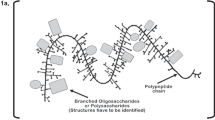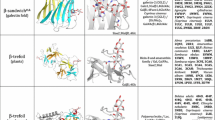Abstract
The chemical mapping of the regions of H-type 2 human blood group-related trisaccharide (Fucα(1–2)Galβ(1–4)GlcNAcβMe) that are recognized by three different lectins, the so-called epitopes, are reviewed together with an account of how and why oligosaccharides form specific complexes with proteins as presently viewed in this laboratory. The occasion is used to report the synthesis of the various mono-O-methyl derivatives of the above trisaccharide that were used in these investigations. Also, Fucα(1–2)Galβ(1–4)XylβMe was synthesized in order to examine whether or not the hydroxymethyl group of the GlcNAc residue participates in the binding reaction.
Similar content being viewed by others
Abbreviations
- Me:
-
methy
- Bn:
-
benzyl
- Ac:
-
acetyl
- Bz:
-
benzoyl
- n-Bu:
-
n-butyl
- NMR:
-
nuclear magnetic resonance
- the GlcNAc:
-
Gal and Fuc residues of the H-type 2 trisaccharide are designated as the a, b and c structural units, respectively.
References
Nikrad PV, Beierbeck H, Lemieux RU (1992)Can J Chem 70:241–53.
Lemieux RU (1994)The Alfred Benzon Symposium No. 36, Complex Carbohydrates in Drug Research, Munskaard, Copenhagen, pp. 188–201.
Fischer E (1894)Ber 27:2985–93.
Lemieux RU, Spohr U (1994)Advances in Carbohydrate Chemistry and Biochemistry 50:1–20.
Lemieux RU (1978)Chem Soc Rev 7:423–52.
Hindsgaul O, Khare DP, Bach M, Lemieux RU (1985)Can J Chem 63:2653–58.
Spohr, U, Paszkiewicz-Hnatiw E, Morishima N, Lemieux RU (1992)Can J Chem 70:254–71.
Cromer R, Spohr, U, Khare DP, LePendu J, Lemieux RU (1992)Can J Chem 70:1511–30.
Lemieux RU, Du M.-H, Spohr U, Acharya S, Surolia A (1994)Can J Chem 72:158–63.
Lemieux RU, Hindsgaul O, Bird P, Narasimhan S, Young WW Jr (1988)Carbohydr Res 178:293–305.
Spohr U, Morishima N, Hindsgaul O, Lemieux RU (1985)Can J Chem 63:2659–63.
Lemieux RU, Venot AP, Spohr U, Bird P, Mandal G, Morishima N, Hindsgaul O, Bundle DR (1985)Can J Chem 63:2664–68.
Bundle DR, Young NM (1992)Current Opinion in Structural Biology 2:666–73.
Rose DR, Przybylska M, To RJ, Kayden CS, Oomen RP, Vorberg E, Young NM, Bundle DR (1993)Protein Science 2:1106–13.
Lemieux RU, Boullanger PH, Bundle DR, Baker DA, Nagpurkar A, Venot A (1978)Nouveau J Chimie 2:321–29.
Lemieux RU, Wong TC, Liao J, Kabat EA (1984)Molecular Immunology 21:751–59.
Hindsgaul O, Norberg T, LePendu J, Lemieux RU (1982)Carbohydr Res 109:109–42.
Lemieux RU, Cromer R, Spohr U (1988)Can J Chem 66:3083–98.
Lemieux RU (1985)Proceedings, VIIIth Int Symp Medicinal Chemistry, Uppsala, Sweden, Swedish Pharmaceutical Press, Stockholm,1:329–51.
Lemieux RU, Delbaere LTJ, Beierbeck H, Spohr U (1991)Ciba Foundation Symposium 158, Wiley, Chichester, 231–48.
Delbaere LTJ, Vandonselaar M, Prasad L, Quail JW, Nikrad PV, Pearlstone JR, Carpenter MR, Smillie LB, Spohr U, Lemieux RU (1990)Can J Chem 68:1116–21.
Delbaere LTJ, Vandonselaar M, Prasad L, Quail JW, Wilson KS, Dauter Z (1993)J Mol Biol 230:950–65.
Shibata S, Goldstein J, Baker DA (1982)J Biol Chem 25:9324–29.
Beierbeck H, Delbaere LTJ, Vandonselaar M, Lemieux RU (1994)Can J Chem 72:463–70.
Beierbeck H, Lemieux RU (1990)Can J Chem 68:820–27.
Good AH, Yau O, Lamontagne LR, Oriol R (1992)Vox Sang 62:180–89.
Spohr U, Hindsgaul O, Lemieux RU (1985)Can J Chem 63:2644–52.
Joint Commission Biochemical Nomenclature (1972)J Biol Chem 247:613–35.
Dejter-Juszynski M, Flowers HM (1973)Carbohydr Res 28:61–74.
Flowers HM (1982)Carbohydr Res 99:170–74.
Roth W, Pigman W (1960)J Am Chem Soc 82:4608–11.
Fujinaga M, Matsushima Y (1966)Bull Chem Soc Jpn 39:185–90.
Hanessian S, Liak TJ, Dixit DM (1981)Carbohydr Res 88:c14-c19.
Dejter-Juszynski M, Flowers HM (1971)Carbohydr Res 18:219–26.
Petrakova E, Spohr U, Lemieux RU (1992)Can J Chem 70:233–40.
Jeanloz RW, Stoffyn PJ (1962)Methods Carbohydr Chem 1:221–27.
Jeanloz RW (1954)J Am Chem Soc 76:5684–86.
Lipták A, Jodál I, Nánási P (1975)Carbohydr Res 44:1–11.
Lee EE, O'Brien E (1975)Carbohydr Res 41:313–17.
Freudenberg K, Smeykal K (1926)Ber 59:100–7.
Helm RF, Ralph J (1991)J Org Chem 56:7015–21.
Helferich B, Wedemeyer K-F (1949)Justus Liebigs Ann Chem 563:139–45.
Spohr U, Lemieux RU (1988)Carbohydr Res 174:211–37.
Wagner D, Verheyden JPH, Moffat JG (1974)J Org Chem 39:24–30.
David S, Thieffry A, Veyières A (1981)J Chem Soc Perkin Trans I, 1796–1801.
Lemieux RU, Hendricks KB, Stick RV, James K (1975)J Am Chem Soc 97:4056–62.
Garegg PJ, Hultberg H, Wallin S (1982)Carbohydr Res 108:97–101.
Lemieux RU (1989)Chem Soc. Rev 18:347–74.
Pereira MEA, Kisailus EC, Gruezo F, Kabat EA (1978)Arch Biochem Biophys 185:108–15.
Author information
Authors and Affiliations
Additional information
This is paper XV in a series devoted to molecular recognition.
Rights and permissions
About this article
Cite this article
Du, MH., Spohr, U. & Lemieux, R.U. The recognition of three different epitopes for the H-type 2 human blood group determinant by lections ofUlex europaeus, Galactia tenuiflora andPsophocarpus tetragonolobus (Winged Bean). Glycoconjugate J 11, 443–461 (1994). https://doi.org/10.1007/BF00731281
Received:
Revised:
Issue Date:
DOI: https://doi.org/10.1007/BF00731281




